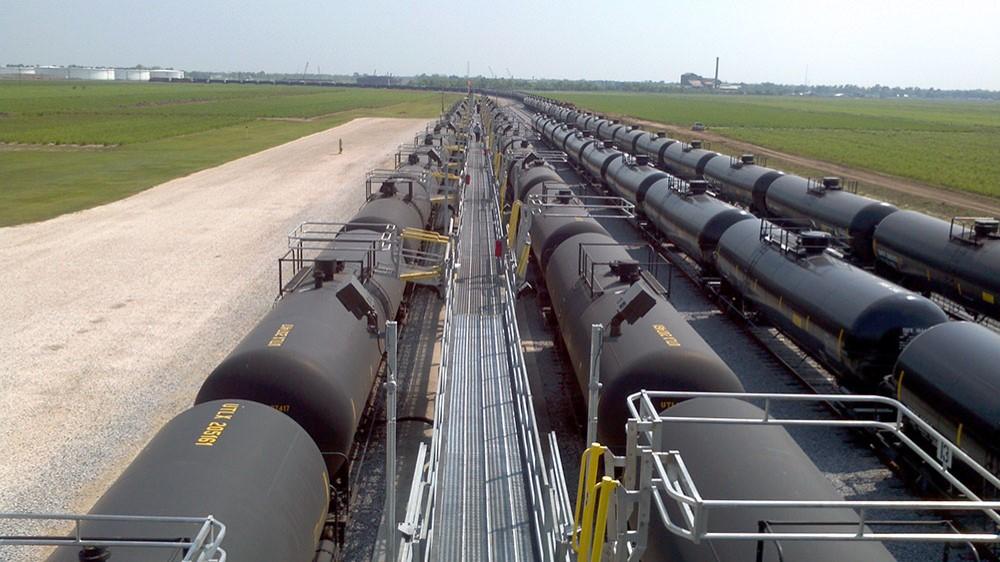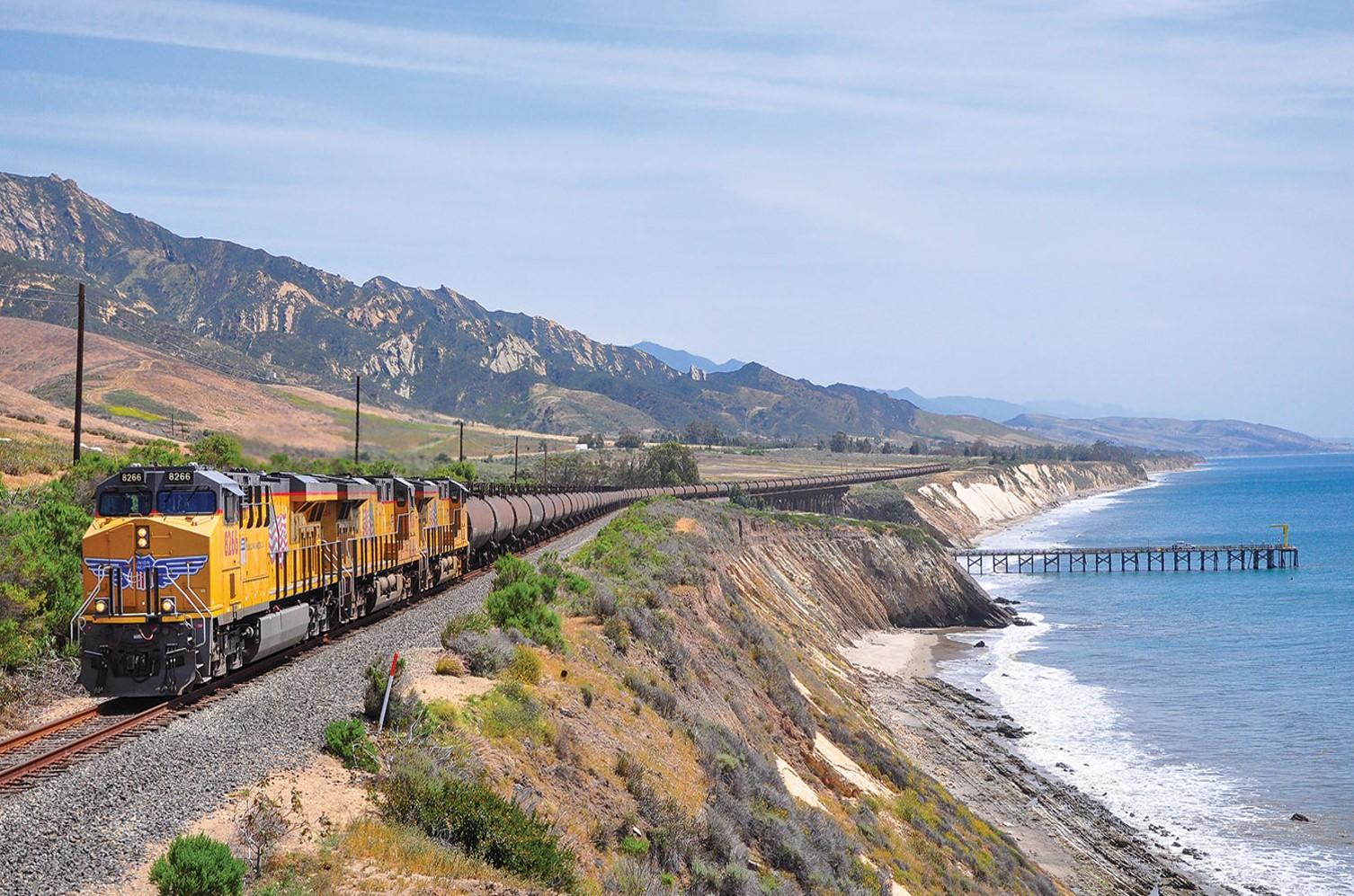How Much Oil Does a Train Car Hold
Take an in-depth look at the rail equipment used in the transportation of liquid commodities, like chemicals, molasses, edible tallow, water and diesel fuel
A tank car is exactly what it sounds like – a large moving tank to carry liquids of just about any kind. From chemicals to food products to the fuel for the cars we drive, tank cars play a major role in transporting the commodities that help us maintain our modern way of life. They also enable safe transportation of hazardous materials, like ethanol and flammable liquids.
For an in-depth look at everything you need to know about tank cars and how they safely transport a wide variety of commodities, read on (and don't miss the video at the end!).
What Is a Rail Tank Car Used For?
A tank car can carry compressed or liquid commodities, like chemicals, molasses, edible tallow, water, diesel fuel and ethanol.
Many chemicals, including ethanol, are considered hazardous materials. Thanks to robust tank car designs, technologies that monitor track and rail car health and first responder training, rail is one of the safest modes of transportation for moving hazardous substances. In fact, more than 99.999% of all hazmat moved annually by rail reaches its destination without a release caused by a train accident.
What Does a Rail Tank Car Look Like?
The body of a tank car is literally a large tank designed to hold liquids. Tank cars are more cylindrical than other rail cars: Imagine a barrel tilted on its side, elongated and expanded to hold between 6,500 gallons to more than 31,000 gallons, and you'll be looking at a tank car.
What Are the Different Rail Tank Car Types?

There are basically two different types of rail tank cars: pressurized and non-pressurized.
- Non-pressurized tank cars are general purpose cars designed to move all types of liquid materials from food grade, to hazardous liquid commodities. These cars are designed and designated for the type of commodities being shipped. Many have an internal lining that is compatible to the materials it carries. Some are even equipped with thermal protection and insulation.
- Pressurized tank cars are used to move compressed gasses and are designed to keep that material under pressure and in the liquid form. Because these cars typically carry pressurized chemicals like LPG, chlorine, anhydrous ammonia, they are built with thicker, normalized steel and extra head protection to greatly reduce the chance of puncture in the unlikely event of a derailment.
How Is a Rail Tank Car Loaded and Unloaded?
On the pressurized tank cars, loading and unloading are done through secure valves with protected housing. Non-pressurized tank cars typically have a bottom outlet where the product is transferred securely. Some tank cars, like those used for carrying acids, will use liquid lines in the housing on top of the cars.
Safety is critical when loading and unloading pressurized and hazardous materials and railroads adhere to strict safety guidelines and regulations put in place by the U.S. Department of Transportation and the Association of American Railroads (AAR). Several agencies and programs also play a major role in educating shippers and establishing initiatives to ensure the safe transport of hazardous materials, including the Railway Supply Institute, TRANSCAER and the American Chemistry Council's Responsible Care Management Program. Union Pacific has an industry-leading hazardous materials response team, Hazardous Materials Management (HMM), dedicated to delivering every tank car safely while being prepared to respond in case of an accident.
How Has the Rail Tank Car Changed Over the Years?
The first railroad tank car was invented in 1865 during the Pennsylvania oil rush, consisting of two wooden tanks placed on a flat rail car — each holding 40-45 barrels of oil to be transported from booming oilfields to refineries. As the demand to move more oil grew, oil haulers shifted to singular cylindrical, riveted iron tanks built to travel by rail. The new tank cars offered more reliability and efficiency, and the same basic cylindrical design is still used today for shipping a wide variety of liquid commodities.
Modern tank cars are constructed of fine grain heat treated steel and incorporate a variety of design features to keep shipments safe. Tank car manufacturers continue to improve upon the design, and in the past several years, thousands of tank cars have been modified with thicker shells, protective valve housings and full-head shields for improved safety and durability.
Why Do Shippers Use Railroad Tank Cars?

- Flexibility - Rail is like a "rolling pipeline," allowing you to move large amounts of liquid commodities to a variety of origins and destinations and giving you the flexibility to adapt and adjust as market dynamics evolve.
- Transit Time - Transit time for both rail and truck are comparable. However, if you are shipping across the border to Mexico, clearing customs can take minutes by train rather than hours – or even days – when you ship by truck. Plus, railroads typically have a team of experts to help you through the process and can even help you get clearance ahead of time.
- Volume - If you are shipping large quantities of LPG on a regular basis, rail might offer the best value. One train can carry as much product as approximately 300 trucks. And if you are looking at it from a fuel cost perspective, you can move one ton of freight 470 miles on a single gallon of diesel fuel by train, which is about three to four times more fuel efficient than trucks.
- Safety - While all shipment options can pose some safety risks, when it comes to shipping large amounts of hazardous materials long distances, rail and pipeline are generally safer than truck. Pipelines and railways typically travel through less-populated areas, reducing the risk to human life.
Rail Tank Car Fun Facts
- Typically, tank cars have up to five times the capacity of truck, holding between 6,500 gallons to more than 31,000 gallons of liquid.
- Tank cars are inspected on a 10-year qualification cycle to maximize safety during transit and while stationary.
- Most tank cars are used to transport only one commodity and are built according to the specifications required for that particular product.
- The first railroad tank car was invented in 1865 during the Pennsylvania oil rush, consisting of two wooden tanks placed on a flat rail car.
Learn More
To learn more about rail tank cars or shipping liquid commodities by rail, get in touch.
Want to learn more about other types of rail car equipment, including boxcars, flatcars, coil cars and covered hoppers? Check out our rail car type guide.
Related Articles
- How to Access the Mexico LPG Market
- Rail Car Types Defined
- How to Ship Energy Products to Mexico by Rail
- What Is Mexico Energy Reform?
- How Do Railroads Keep Cross-Border Shipments Safe?
- What Is a Refrigerated Boxcar?
- Transportation Modes Revealed: A Comprehensive Look
- Quiz: Can Your Product Ship by Rail?
- What Products Can Be Transloaded?
- How Are Products Transloaded?
- Transloading: Decoded
"What Is a Rail Tank Car?" Video
How Much Oil Does a Train Car Hold
Source: https://www.up.com/customers/track-record/tr052521-what-is-a-rail-tank-car.htm
0 Response to "How Much Oil Does a Train Car Hold"
Post a Comment